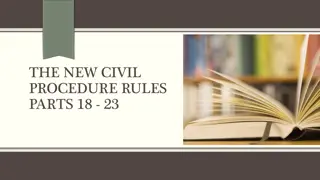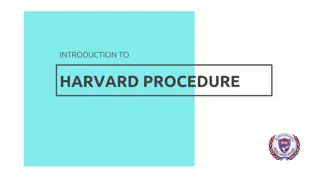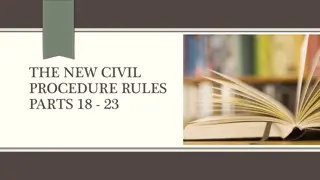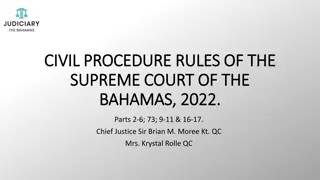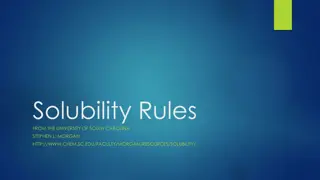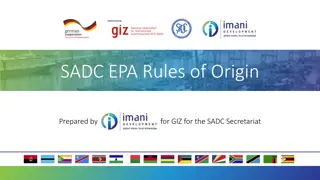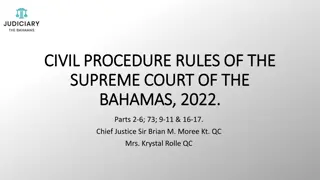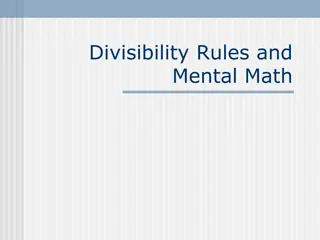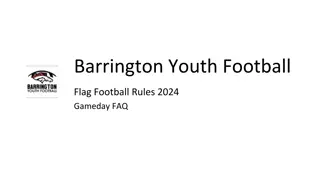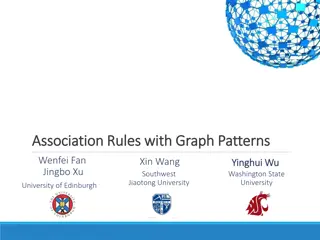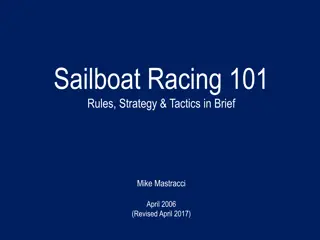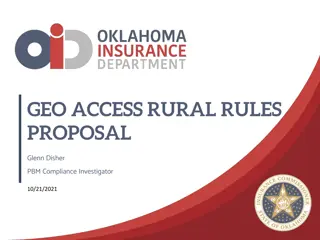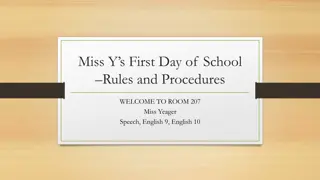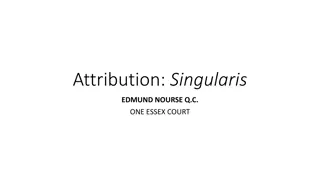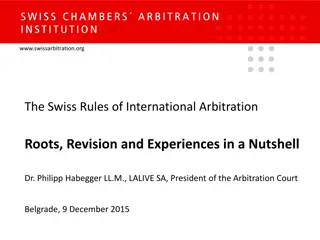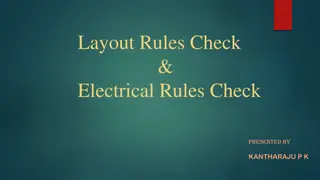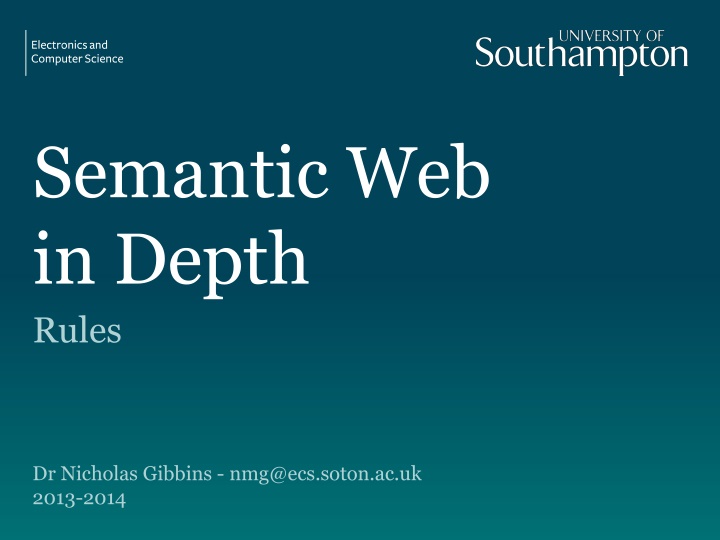
Rules and Knowledge Representation in the Semantic Web
Delve into the role of rules in the Semantic Web, exploring how they enhance knowledge representation and overcome limitations in formalisms like OWL and RDFS. Discover various rule-based languages like Prolog and RuleML, alongside insights into SPARQL and its usage in constructing queries. Understand the relevance and evolution of rule languages in the context of the Semantic Web's layered architecture.
Download Presentation

Please find below an Image/Link to download the presentation.
The content on the website is provided AS IS for your information and personal use only. It may not be sold, licensed, or shared on other websites without obtaining consent from the author. If you encounter any issues during the download, it is possible that the publisher has removed the file from their server.
You are allowed to download the files provided on this website for personal or commercial use, subject to the condition that they are used lawfully. All files are the property of their respective owners.
The content on the website is provided AS IS for your information and personal use only. It may not be sold, licensed, or shared on other websites without obtaining consent from the author.
E N D
Presentation Transcript
Semantic Web in Depth Rules Dr Nicholas Gibbins - nmg@ecs.soton.ac.uk 2013-2014
The Role of Rules The Semantic Web concentrates on declarative forms of knowledge representation OWL, RDF Schema Rules are a common form of procedural knowledge representation elsewhere in Knowledge Engineering Expert Systems CLIPS, JESS, OPS, Prolog
The Role of Rules The KR formalisms of the Semantic Web have expressive limitations which can be overcome by rule-based knowledge For example, we cannot express the fact that a person s parent s brother is the person s uncle in either RDFS or OWL (including OWL Full) No role composition in OWL 1.0
The Role of Rules Trivial to express in a language like Prolog: hasUncle(X,Y) :- hasParent(X,Z), hasBrother(Z,Y). hasBrother(X,Y) :- isMale(Y), hasParent(X,Z), hasParent(Y,Z).
The Semantic Web layer cake User Interface and Applications Attribution Trust Proof Explanation Encryption OWL Rules Ontologies + Inference SPARQL (queries) Signature RDF Schema Metadata RDF XML + Namespaces Standard syntax Identity URI Unicode
SPARQL CONSTRUCT PREFIX foaf: <http://xmlns.com/foaf/0.1/> PREFIX vcard: <http://www.w3.org/2001/vcard-rdf/3.0#> CONSTRUCT { ?x vcard:FN ?name . ?x vcard:EMAIL ?mail . } WHERE { ?x foaf:name ?name . ?x foaf:mbox ?mail . }
SPARQL CONSTRUCT is not a rule language From the Data Access Working Group Charter: While it is hoped that the product of the RDF Data Access Working Group will be useful in later development of a rules language, development of such a rules language is out of scope for this working group. However, any serializations of a query language must not preclude extension to, or inclusion in, a rules language. The group should expend minimal effort assuring that such an extension be intuitive and and consistent with any query language produced by the group.
Rules and the Semantic Web Several proposed rule languages for use with the SW: RuleML N3 Rules Jena Rules Semantic Web Rule Language (SWRL) Rule Interchange Format (RIF)
Rule Format The majority of rules in rule-based systems are of the form: A B1 B2 Bn A is known as the consequent or head of the rule B1 Bn are known as the antecedents or body of the rule Also known as Horn Clauses (disjunction with at most one positive literal)
Description Logics and Rules Some work on designing DLs which include trigger rules of the form: C D (if an individual is a member of C, then it must be a member of D
Description Logics and Rules C D is not the same as saying C D (every instance of C is an instance of D) C D is equivalent to saying D C (contrapositive) The trigger rule C D is not equivalent to D C DLs with rules include an epistemic (modal) operator K: KC can be read as the class of things which are known to be of class C C D is equivalent to KC D Used as a foundation for SWRL, etc
N3 Rules Defines log: namespace for logical operators Some triples are special interpreted as components of rules log: namespace puts ontology into OWL Full Relies on N3 syntax for graphs: {} (not in Turtle, etc) Not widely implemented cwm (TimBL s pet reasoner) +?
N3 Rules General form: { antecedent graph } log:implies { consequent graph }. Example: {?x ont:parent ?y. ?y ont:brother ?z. } log:implies {?x ont:uncle ?z. }.
Jena Rules Jena RDF/OWL library contains support for forward- and backward-chaining rules Only implemented in Jena Syntax: [rule name: antecedents -> consequent ] Antecedents expressed as triple patterns (unfortunately not in a SPARQL-like syntax)
Jena Rule Example # Example rule file @prefix ont: <http://example.org/ontology#>. @include <RDFS>. [rule1: (?x ont:parent ?t) (?t ont:brother ?z) -> (?x ont:uncle ?z)] can include other rulebases these are the entailment rules for RDFS
Semantic Web Rule Language
SWRL Submitted to W3C in 2004 Based on RuleML subset and OWL XML and RDF-based serialisations (also, human-readable abstract syntax) Obeys constraints put on OWL re: disjointness of instances and datatype values Two types of variable in expressions I-variable matches class instances D-variable matches datatype values
SWRL Rule Example hasParent(?x1,?x2) hasBrother(?x2,?x3) hasUncle(?x1,?x3) In abstract syntax: Implies(Antecedent(hasParent(I-variable(x1) I-variable(x2)) hasBrother(I-variable(x2) I-variable(x3))) Consequent(hasUncle(I-variable(x1) I-variable(x3))))
SWRL Rule Example Artist(?x) artistStyle(?x,?y) Style(?y) creator(?z,?x) style/period(?z,?y) Implies(Antecedent(Artist(I-variable(x)) artistStyle(I-variable(x) I-variable(y)) Style(I-variable(y)) creator(I-variable(z) I-variable(x))) Consequent(style/period(I-variable(z) I-variable(y))))
SWRL Rule Example Artist(?x) ( 1 artistStyle)(?x) creator(?z,?x) ( 1 style/period)(?z) Implies(Antecedent(Artist(I-variable(x)) Style(I-variable(y)) creator(I-variable(z) I-variable(x))) Consequent((restriction(style/period maxCardinality(1)) (I-variable(z)))) (restriction(artistStyle maxCardinality(1))) (I-variable(x))
SWRL XML Syntax <ruleml:imp> </ruleml:imp> <ruleml:_rlab ruleml:href="#example1"/> <ruleml:_body> <swrlx:individualPropertyAtom swrlx:property="hasParent"> <ruleml:var>x1</ruleml:var> <ruleml:var>x2</ruleml:var> </swrlx:individualPropertyAtom> <swrlx:individualPropertyAtom swrlx:property="hasBrother"> <ruleml:var>x2</ruleml:var> <ruleml:var>x3</ruleml:var> </swrlx:individualPropertyAtom> </ruleml:_body> <ruleml:_head> <swrlx:individualPropertyAtom swrlx:property="hasUncle"> <ruleml:var>x1</ruleml:var> <ruleml:var>x3</ruleml:var> </swrlx:individualPropertyAtom> </ruleml:_head>
SWRL RDF Syntax <swrl:Variable rdf:ID="x1"/> <swrl:Variable rdf:ID="x2"/> <swrl:Variable rdf:ID="x3"/> <ruleml:Imp> <ruleml:body rdf:parseType="Collection > <swrl:IndividualPropertyAtom> </swrl:IndividualPropertyAtom> <swrl:IndividualPropertyAtom> </swrl:IndividualPropertyAtom> </ruleml:body> <swrl:propertyPredicate rdf:resource="⪚hasParent"/> <swrl:argument1 rdf:resource="#x1" /> <swrl:argument2 rdf:resource="#x2" /> <swrl:propertyPredicate rdf:resource="⪚hasSibling"/> <swrl:argument1 rdf:resource="#x2" /> <swrl:argument2 rdf:resource="#x3" />
Rule Interchange Format
Rule Interchange Format W3C Working Group chartered in late 2005 More expressive language than SWRL Common core with extensions Reached Recommendation in June 2010
Rule Interchange Format Defines XML syntax and non-XML presentation syntax (c.f. OWL) Latest version from: http://www.w3.org/2005/rules/wiki/RIF_Working_Group
RIF Dialects Two dialects (building on a common core): RIF Basic Logic Dialect Monotonic condition and conclusion Statements are either true or false The values of predicates cannot be changed, you can only add new staements RIF Production Rule Dialect Non-monotonic condition and conclusion Values of predicates can be changed
RIF Basic Logic Dialect Definite Horn rules Disjunction with exactly one positive literal A :- B and C and D N-ary predicates (sugared syntax)
RIF Structure Rules occur in Groups: Group( (Forall ?x Q(?x) :- P(?x)) (Forall ?x Q(?x) :- R(?x)) ) Groups occur in Documents: Document( ) Group( (Forall ?x Q(?x) :- P(?x)) (Forall ?x Q(?x) :- R(?x)) ) Group( (Forall ?y R(?y) :- S(?y)) )
RIF Example Document( Prefix(cpt http://example.com/concepts#) Prefix(ppl http://example.com/people#) Prefix(bks http://example.com/books#) Group ( Forall ?Buyer ?Item ?Seller ( cpt:buy(?Buyer ?Item ?Seller) :- cpt:sell(?Seller ?Item ?Buyer) ) cpt:sell(ppl:John bks:LeRif ppl:Mary) ) )
RIF Example Document( Prefix(dbp http://dbpedia.org/property/) Prefix(my http://mydata.org/resource#) Prefix(rdfs http://www.w3.org/2000/01/rdf-schema#) Group ( Forall ?mname ?aname ?movie ?actor my:actorIn(?aname ?mname) :- And( dbp:starring(?movie ?actor) rdfs:label(?movie ?mname) rdfs:label(?actor ?aname) ) ) )
RIF Example Document( Prefix(dbp http://dbpedia.org/property/) Prefix(my http://mydata.org/resource#) Prefix(rdfs http://www.w3.org/2000/01/rdf-schema#) Group ( Forall ?mname ?aname ?movie ?actor my:actorIn(?aname ?mname) :- And( ?movie[dbp:starring -> ?actor rdfs:label -> ?mname] ?actor[rdfs:label ?aname] ) ) )

